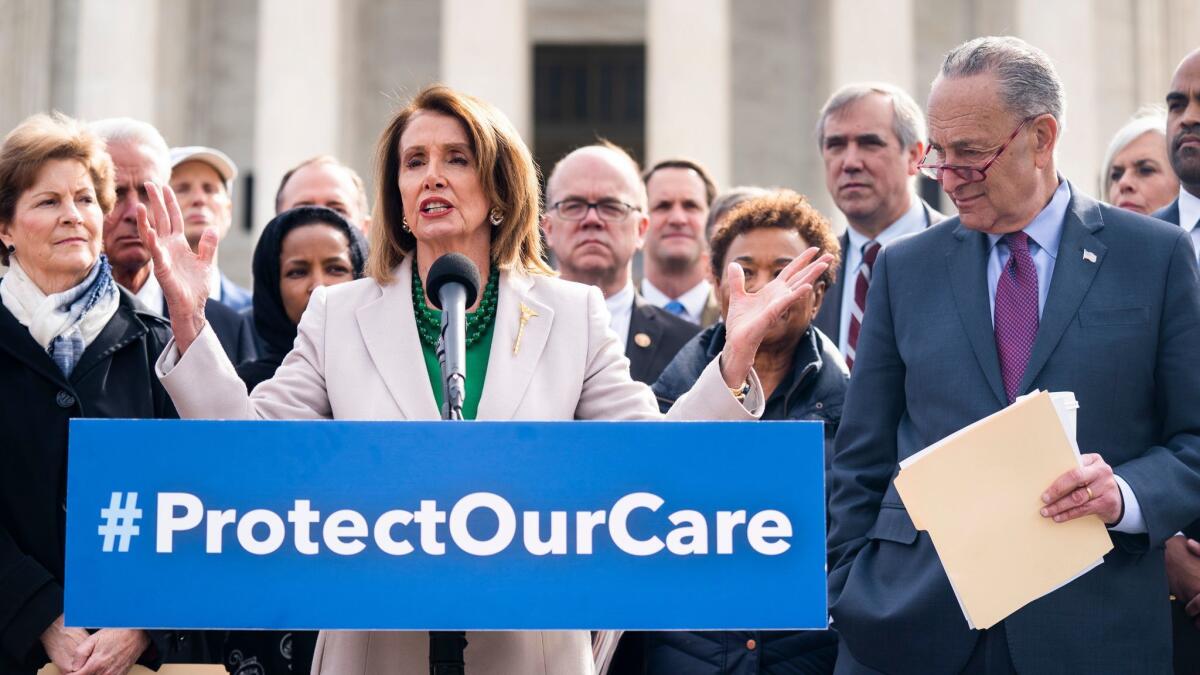Column: Health insurers learn how to make Obamacare work — for themselves and their customers

- Share via
After grousing for years about the individual insurance market created by the Affordable Care Act — and providing fuel for the ACA’s enemies — the health insurance industry is finding Obamacare to be a profit center.
The latest evidence comes from the Kaiser Family Foundation, which analyzed a nationwide database of financial results covering about 80% of the individual market. According to the foundation’s report published this week, 2018 was “the most favorable year in the ACA-compliant market’s history.”
The insurers were so profitable, in fact, that they’ll have to rebate a record $800 million in overcharges to consumers by Sept. 30. The rebates are required by the ACA.
Individual market insurers saw better financial performance in 2018 than in all the earlier years of the ACA and returned to...pre-ACA levels of profitability.
— Kaiser Family Foundation
The foundation’s report matches earlier findings and projections by the healthcare consulting firm Milliman and experts such as David Anderson of Duke University. It also confirms long-held expectations by the ACA’s architects and supporters — that the first years of the individual exchange market (starting in 2014) would be difficult for insurers, because they would be serving a market that hadn’t existed before and therefore provided little guidance for premium-setting.
The expectation, however, was that the market would eventually stabilize. That’s exactly what has happened.
“Individual market insurers saw better financial performance in 2018 than in all the earlier years of the ACA,” the Kaiser Family Foundation finds, “and returned to, or even exceeded, pre-ACA levels of profitability.”
Armed with more than three years of experience, the insurers have been able to better judge their expenses and set premiums accordingly. Indeed, premiums and costs would synchronize even better if not for the determined sabotage of congressional Republicans and the Trump administration, which injected new uncertainties into rate-setting in 2017 and 2018.
Those uncertainties included doubts about whether the ACA’s individual mandate would be enforced (Congress in 2017 reduced the mandate penalty to zero as of this year), whether cost-sharing subsidies would be paid to insurers (Trump canceled them in 2017), and whether the ACA would be repealed (it wasn’t).
Trump also reduced spending on advertising and outreach sharply, raising doubts about enrollment. “Without these policy changes,” the Kaiser Family Foundation report says, “it is likely that insurers would generally have required only modest premium increases in 2018.” But the political uncertainties created in Washington supplanted the market uncertainties that the insurers finally had figured out. “Amid these policy changes and legislative uncertainty, insurers raised benchmark premiums by an average of 34% going into 2018.”
That rendered 2018 insurance policies “massively overpriced,” Anderson notes. The coming rebates are the result.
It’s proper to point out that big health insurers did their utmost to undermine public confidence in the ACA in the first years of the individual exchanges. They griped incessantly about annual losses on the exchanges, even though the law had been written to give them a central role in serving that marketplace.
Aetna, as we’ve reported, tried to hold the ACA hostage to its desire to complete a $34-billion merger with Humana, threatening to abandon the exchanges if the Obama administration sued to block the merger. The lawsuit was filed, and Aetna bailed out, claiming falsely that it did so strictly for economic reasons. Republicans duly cited Aetna’s move as evidence that the ACA exchanges were unworkable.
Among the other big insurers that distinguished themselves with the volume of their whining about Obamacare exchange losses was UnitedHealth, which had never played in the individual market and royally messed up its pricing. When that produced losses, the insurer fled with its tail between its legs.
The numbers crunched by the Kaiser Family Foundation show that financial conditions in the individual market began to improve in 2016, when average premiums first began to outpace claims. By last year, when average monthly premiums per enrollee were $559, they outpaced average per capita claims by $167. (The vast majority of enrollees—about 80%--don’t pay those premiums; they’re subsidized to the tune of at least 90% of the cost of benchmark silver plans, often the most popular on the exchanges.)
The stabilized finances of the individual marketplace have been a distinct boon for consumers as insurers reenter the marketplace or expand their participation. The Kaiser foundation has reported that the share of counties with only a single insurer in the ACA marketplace has declined to 37% this year from 52% in 2018, while those with three or more insurers have risen to 23% from 18%. This year, only 17% of ACA enrollees had an option of only one insurer, down from 26% in 2018; some 58% could choose among three or more.
The anti-ACA rhetoric flowing from Trump and the GOP hasn’t ebbed. Indeed, the administration has redoubled its attack on the law by endorsing a move by Texas and other red states to have it declared unconstitutional by a federal court in the South. That irresponsible attack can only create more uncertainty for insurers and their customers, which as experience shows, only raises costs for consumers.
Keep up to date with Michael Hiltzik. Follow @hiltzikm on Twitter, see his Facebook page, or email michael.hiltzik@latimes.com.
Return to Michael Hiltzik’s blog.
More to Read
Inside the business of entertainment
The Wide Shot brings you news, analysis and insights on everything from streaming wars to production — and what it all means for the future.
You may occasionally receive promotional content from the Los Angeles Times.











